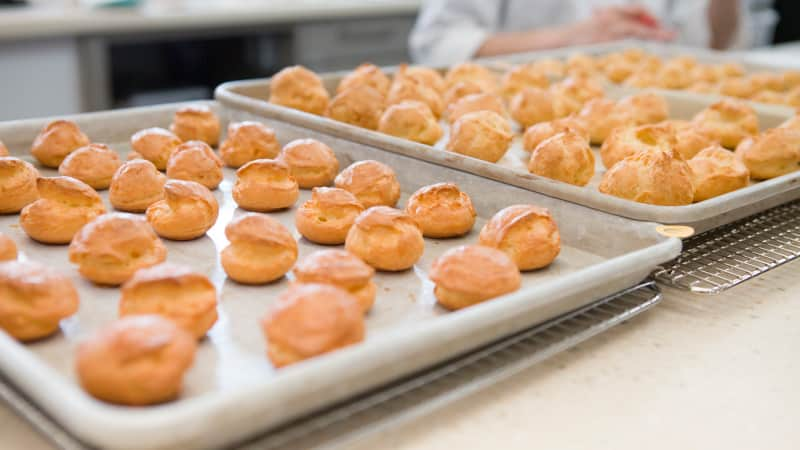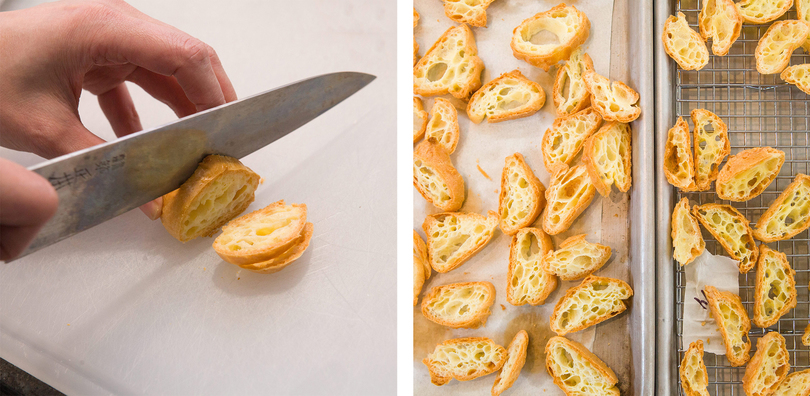My Goals
- Plenty of cheese flavor
- Airy, hollowed-out interiors
- Even, golden-brown color
Published Dec. 6, 2017.

While some French classics can feel stodgy and old-fashioned (think Mornay sauce or chicken fricassee), I'm willing to bet that gougères (and their sweet cousins, profiteroles) will never go out of style. It's not just that their crisp, browned exteriors and airy, popover-like interiors flavored with nutty Gruyère cheese give them huge appeal. These two-bite puffs also look impressive and can be made in advance and reheated.
The foundation for gougères (and profiteroles) is pâte à choux, or choux pastry. The most classic versions involve cooking butter, water, and flour in a saucepan until the loose batter stiffens and turns into a dough—this ensures that it's pipeable rather than a runny mess. Eggs then get beaten in, one at a time, for structure and flavor. To make the choux into gougères, the next steps are to stir in grated cheese, pipe the dough into little rounds, and bake. Starting in a hot oven (425 degrees is typical) ensures that the puffs expand dramatically. The temperature is then lowered to 375 degrees or so to finish cooking them through.

Following a few such recipes, I found room for improvement. Fresh out of the oven, the best puffs were crisp outside and just custardy enough inside to provide contrast—but if they sat around for even 20 minutes, they softened. I also found that, depending on the oven, the puffs could overbrown. They weren't nearly cheesy enough, and beating in the eggs by hand was a chore.

I cooked a paste of ½ cup of water, 5 tablespoons of butter, and ½ cup of flour along with a little salt and cayenne for depth. But instead of beating in the eggs by hand, I worked them into the dough in a food processor, along with an extra egg white. The proteins in the white would boost crispness and provide structure for more airiness. The water in the white would provide steam to help the dough puff.
I also adjusted the baking process. With the help of a probe thermometer, I confirmed that when I turned the dial on my well-insulated oven from 425 to 375 degrees, the temperature didn't always drop much, depending on where the oven was in its heating cycle. When the temperature didn't drop much, the puffs browned and dried out on their exteriors by the time the interiors were done. But when I pulled them earlier, the interiors were gummy and dense. I wondered if I could get more consistent results by simply shutting off the oven. This would guarantee that the temperature inside the oven, no matter how well insulated, would drop more rapidly. I gave this approach a shot: After 15 minutes at 425 degrees, I turned off the oven and left the puffs inside with the door closed for another 15 minutes. This batch came out just right: perfectly browned with the ideal airy centers.
With the choux settled, it was time to bring cheese into the picture. I made another batch of choux, but this time after adding the eggs to the processor I added 4 ounces (1 cup) of grated Gruyère—a full ounce more than other recipes—and then piped my rounds and baked them as before.
When I removed my gougères from the oven, I could see that they were overbrowned on the bottoms and a little greasy. But the bigger problem was the interiors, which were dense and doughy. When I inspected them carefully, I noticed that most of the air bubbles had tears in their walls. The addition of such a hefty amount of cheese was preventing the bubbles from expanding fully.
To find a solution, I gave the choux ingredients a closer look. First, I considered the gluten-forming proteins in the flour. Gluten creates a stretchy network that provides structure to baked goods, so it seemed logical that more gluten would provide more strength so that the bubbles could expand properly without tearing. To that end, I switched from using all-purpose flour to higher-protein bread flour. Second, since fat inhibits gluten formation, I reduced the amount of butter from 5 tablespoons to 2; this would mitigate greasiness. To my disappointment, these changes brought only marginal improvement.

I wondered if I could do better by manipulating the egg proteins. Raw egg proteins are coiled up in tight bundles. When heated, they uncoil and form strong, springy networks. I ran a series of tests: more whole eggs, more whites, and more yolks in varying amounts. But in all cases, the dough became too wet, making it hard to work with. Was there some way to get the two eggs and one white I'd been using all along to set up and establish some structure more quickly?
Egg proteins unwind not only when heated but also when beaten well (something we've learned from making omelets and baked goods). But after a chat with our science editor, I discovered another way to make them unwind more quickly: Combine them with salt. Up to this point, I'd been adding the salt to the dough, but in my next batch I added it directly to the eggs instead. What an impressive difference one little change made. When I tore open these gougères, I found the airy centers I was after.
Adding a little salt is important in almost all recipes to enhance flavor; the salt in our Gougères also improves their structure, allowing us to make puffs that are airy, not dense. But how the salt is added is critical. Rather than add it to the dough, we beat the salt with the eggs before they are combined with the flour mixture. Why?
Mixing salt with the eggs changes the electrical charges on the egg proteins so they uncoil at a lower temperature, allowing them to set up into a strong network earlier in the baking time. This means they can buttress the dough as it inflates, ensuring that it doesn’t collapse under the added weight of the cheese. Bottom line? Our Gougères contain fewer and larger interior bubbles, creating the airy results we were after.
Still, the puffs were browning too much on their bottoms. Baking them on the upper-middle rack helped, but it wasn't enough. The fix was nesting my rimmed baking sheet in a second baking sheet, which created a thin air gap between the two. This gap insulated the pastry bottoms just enough to keep them from overbrowning.
Now I took a closer look at portioning the dough. Piping the dough with a pastry bag was of course an option, but two spoons worked almost as well. (With this dough, a zipper-lock bag with the corner snipped off was not a possibility, as the dough was too stiff and came out of the bag in odd shapes.) Whether I used a pastry bag or spoons, I only had to smooth away any creases or large peaks with the back of a spoon coated in vegetable oil spray.
Use the back of a spoon lightly coated with vegetable oil spray to smooth away any creases and large peaks on each mound of dough.
From here, I came up with a few more recipes that varied the cheese and the spices, making sure to pick cheeses that are similar in age and texture—and, thus, moisture content—to Gruyère so as not to alter my puffs' perfect texture. Manchego and black pepper paired well, as did Gouda and smoked paprika.
These luxuriously cheesy, delicately crisp bites are sure to make an appearance at my next party. Though they'll stay perfectly crisp for a full hour, I don't expect they'll last that long.
Plenty of cheese flavor
Most gougères don’t boast much cheese flavor. We add 4 ounces of Gruyère (a full ounce more than most recipes) to ensure that its nutty, complex flavor comes through.
Airy, hollowed-out interiors
Adding an extra egg white to the dough provides more water, which turns to steam in the oven for better puffing. Starting the puffs in a hot 425-degree oven helps ensure that the interiors expand before the exteriors set. Also, by whisking the eggs with salt before adding them to the dough, we encourage the egg proteins to unwind more quickly, which helps build structure and creates more open and airy centers.
Even, golden-brown color
Simply turning off the oven after a high-temperature start evens out the color of the puffs. To prevent overbrowning on the bottoms of the puffs, we move the rack to the upper-middle position so that they are far from the heat source, and we bake them on a pair of nested rimmed baking sheets. The air gap between the two sheets provides insulation so that the undersides of the puffs remain cooler.

This is a members' feature.